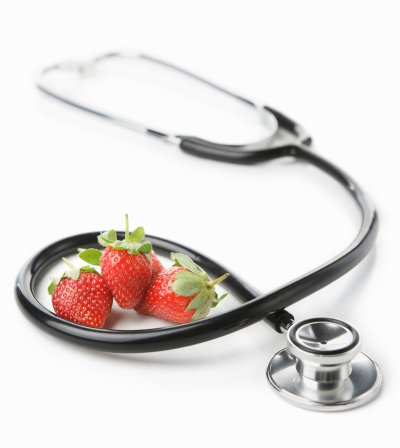
In light of the COVID-19 public health emergency Americans are facing, it’s important to understand how to build your immune system. However, conflicting messages in the media open the door to confusion.
Our registered dietitian explains what factors play a role in immunity, eating for health, and how to boost immune systems naturally.
Factors Influencing the Immune System
Factors that can influence immunity include[i]:
- Diet
- Sleep
- Stress
- Exercise
- Microbiome
- Germs
Eating for Health
Eating for health means increasing whole foods while cutting back on processed foods high in sugar, salt, and saturated fats. People are cautioned not to look for a single “super food” to prevent illness, but rather, start eating a balanced diet to build a strong immune system over time.
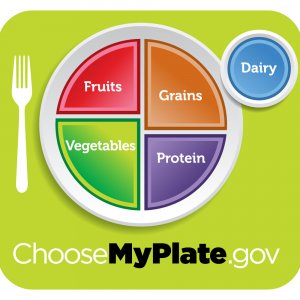
USDA’s My Plate is an easy way to balance your diet for immune system health.
The Dietary Guidelines for Americans promotes the “My Plate” method of eating for health: [ii]
- ½ of your plate: Colorful fruits and non-starchy vegetables
- ¼ of your plate: Lean protein
- ¼ of your plate: Whole grains or starch
- Low-fat dairy is also encouraged at each meal for those who tolerate lactose.
Consistently building your plate this way prepares the body to fight illness and stress. Eating for health is a long-game; popping a few berries in your mouth when you start to feel a cold coming on will have limited effect. However, if you eat a variety of fruits and vegetables each day, your cells will be better prepared to overcome viruses and infections when your body does encounter them.
The Rainbow of Fruits & Veggies at the Heart of Immune Boosting Foods
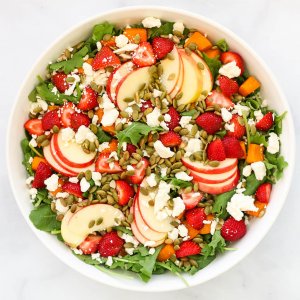
Eating the rainbow of fruits and vegetables every day is key to increasing immune cell responses to bacteria and viruses. The phytochemicals in fruits and vegetables that promote health depend on the color of the food.
For instance, blue, purple, and red fruits like strawberries provide antioxidant and antimicrobial activity. These immune boosting foods help protect cells from damage and may reduce the risk of diabetes, cancer, stroke, and heart disease.[iv]
Green vegetables, on the other hand, are recognized as foods good for the immune system because they have anti-cancer properties and protect against neural tube defects in pregnancy.[iv]
People with underlying chronic conditions including heart disease, cancer, respiratory dysfunction, and diabetes are at higher risk for contracting coronavirus.[iii]
Therefore, it’s important to strengthen the body against these types of non-communicable diseases with a variety of immune boosting foods first, so that contagious viruses have less impact on the body.
Eating a single color in the diet is like going to school and learning a single subject. If first graders were only taught physical education- that would be important- but they would miss out on learning how to add, subtract, read, and write. Similarly, if a person were to only eat one color of fruits and vegetables (like greens), they risk missing out on nutrients that may promote a more complete immune response.
| Color | Food Sources | Role in Immunity[iv] |
| Red/Purple/Blue | Strawberries, other berries, grapes, red cabbage, cherries, onions, radishes | Antioxidant & Antimicrobial anthocyanins
Fights colds, diabetes, heart disease, high blood pressure, high cholesterol, cancer, stroke, cognitive impairment |
| Green | Spinach, asparagus, broccoli, peas, kiwi, green beans, green cabbage, celery, cucumber | Antioxidant isothiocyanates & indoles
Fights cancer and neural tube birth defects |
| Orange/Yellow | Carrots, sweet potato, pumpkin, mango, oranges, squash, pineapples, peaches, nectarines, apricots, grapefruit | Beta-carotene & lutein
Maintains healthy mucous membranes and eyesight |
| Brown/White | Cauliflower, brown pears, mushrooms, white peaches, garlic, bananas, potatoes, dates, onions, ginger, parsnips, turnips | Antiviral & antibacterial allicin
Fights off colds, viruses, and infection |
Protein is Vital for Repair and Recovery from Illness
Protein is also essential for growth and illness recovery. Protein repairs cells and DNA damage caused by illnesses. Animal protein like skinless poultry, fish, yogurt, eggs, low-fat cheese, and milk are great sources of protein. If you choose vegetarian protein, pair it with vitamin C-rich foods like strawberries. Iron from plant protein is difficult to absorb without vitamin C.
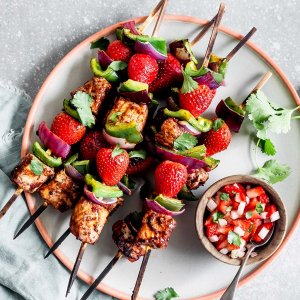
Protein like tuna helps recovery from illness.
Foods High in Vitamin C
Food sources of vitamin C are more effective at strengthening immunity and overall health than supplements.[v] In addition, fruits and vegetables like strawberries offer much more than vitamin C; all of their micronutrients work together to help prevent and fight disease.
One serving of eight strawberries provides all the vitamin C you need for a day. Oranges, red peppers, cantaloupe, papaya and kale are also foods high in vitamin C.
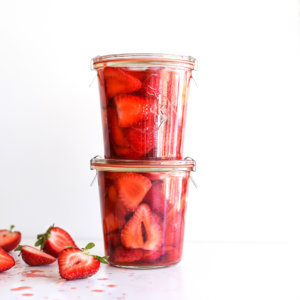
One serving of 8 strawberries has a full day’s worth of vitamin C.
Little Evidence that Supplements Boost Immunity
Outside of supplementing with vitamin D if you’re deficient in the vitamin (many are in the winter who live in northern climates), there is little clinical evidence that supplements are effective in bolstering the immune system (despite the many claims being made on social media, TV ads, and the internet).
There is poor scientific support for popping extra zinc lozenges, vitamin C tablets, elderberry, or echinacea to boost your immune system. In fact, you can do damage by overloading on certain supplements not prescribed by a doctor (including vitamin C and zinc).
Vitamin C from fruits and vegetables is the best source of vitamin C- not supplements.[v]
How to Boost Immune System Naturally
-
Exercise’s Role in Immunity
For those who want to know how to boost the immune system naturally, after diet, physical activity is key. Exercise is another long-term approach to building strength against germs and disease.
Working out not only builds muscle, it also reduces abdominal fat, high blood pressure, cholesterol, and stress- all risk factors for disease. It can help you sleep better and decrease symptoms of depression and anxiety.
The American Heart Association recommends adults get at least 150 minutes of moderate cardio exercise and at least three days of strength-building exercises per week.[vi]
-
Sleep & Stress
Increasing sleep and decreasing stress are also on the list of how to boost your immune system naturally. Do your best to get adequate sleep (7+ hours each night).[vii]
While anxiety and stress are expected right now, techniques to help manage it may include talking to someone, checking in on loved ones, exercise, sleep, and eating a nutritious diet.
-
Microbiome & Germs
We can’t neglect the role bacteria play in all of this. While we may be wiping out harmful germs and bacteria on surfaces, it’s critical to feed our guts good bacteria.
Pre- and pro-biotics are immune boosting foods because they feed the good bacteria in our guts. Prebiotics include fiber from fruits, vegetables, and unprocessed cocoa, while probiotics include strawberries, apples, kefir, kombucha, sauerkraut, pickles, miso, tempeh, kimchi, sourdough bread, and some cheeses.[viii]
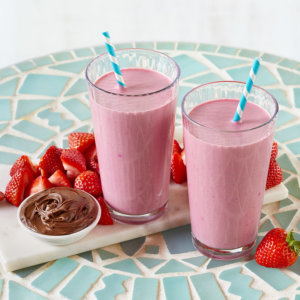
Strawberries, kombucha, yogurt, and kefir are probiotic foods that support health.
Public Health Guidance
We all know this, but wash your hands, avoid touching your face, sneeze/cough into your elbow, and stay home if you have symptoms.
Heed advice of health authorities. The CDC website is a reliable source of information on the coronavirus.
References
[i] Brodin, P., Jojic, V., Gao, T., Bhattacharya, S., Angel, C. J., Furman, D., Shen-Orr, S., Dekker, C. L., Swan, G. E., Butte, A. J., Maecker, H. T., & Davis, M. M. (2015). Variation in the human immune system is largely driven by non-heritable influences. Cell, 160(1-2), 37–47. https://doi.org/10.1016/j.cell.2014.12.020
[ii] United States Department of Agriculture. (2020). What is my plate? ChooseMyPlate.gov. https://www.choosemyplate.gov/eathealthy/WhatIsMyPlate
[iii]Kaiser Family Foundation. (2020). About 4 in 10 adults in the U.S. are at greater risk of developing serious illness if infected with coronavirus, due to age or underlying health conditions. https://www.kff.org/global-health-policy/press-release/about-4-in-10-adults-in-the-u-s-are-at-greater-risk-of-developing-serious-illness-if-infected-with-coronavirus-due-to-age-or-underlying-health-conditions/
[iv] Schaeffer, J. (2008). Color me healthy- eating for a rainbow of benefits. Today’s Dietitian. https://www.todaysdietitian.com/newarchives/110308p34.shtml
[v] Office of Dietary Supplements. (2020). Vitamin C. National Institutes of Health. https://ods.od.nih.gov/factsheets/VitaminC-Consumer/
[vi] American Heart Association. (2018). American Heart Association recommendations for physical activity in adults and kids. Heart.org. https://www.heart.org/en/healthy-living/fitness/fitness-basics/aha-recs-for-physical-activity-in-adults
[vii] Centers for Disease Control & Prevention. (2019). Are you getting enough sleep? CDC.gov. https://www.cdc.gov/features/sleep/index.html
[viii] Harvard Medical School. (2020). How to get more probiotics. Harvard Health Publishing. https://www.health.harvard.edu/staying-healthy/how-to-get-more-probiotics
